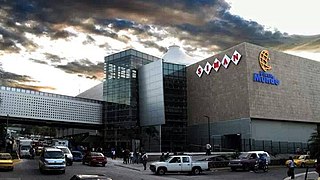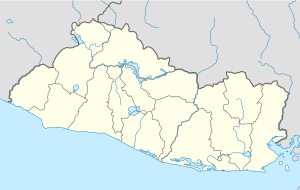
San Salvador is the capital and the largest city of El Salvador and its eponymous department. It is the country's political, cultural, educational and financial center. The Municipality of San Salvador has 209,633 inhabitants (2020). The Metropolitan Area of San Salvador, which comprises the capital itself and 13 of its municipalities, has a population of 2,404,097. The urban area of San Salvador has a population of 1,600,000 inhabitants.

Chalatenango is a department of El Salvador located in the northwest of the country. The department's capital city is the city of Chalatenango, which shares the same name as the department. Chalatenango covers a land area of 779 sq mi and contains over 192,000 inhabitants. Chalatenango's maximum elevation, located at Cerro El Pital, is 8,960 feet (2,730 m).

San Salvador is a department of El Salvador in the west central part of the country. The capital is San Salvador, which is also the national capital. The department has North of the Rio Lempa Valley, the "Valle de las Hamacas" and a section of Lake Ilopango. Some of the department's cities that are densely populated are: San Salvador, Ciudad Delgado, Mejicanos, Soyapango, Panchimalco and Apopa. The department covers an area of 886.2 square kilometres (342.2 sq mi) and the last census count in 2017 reported 2,404,097 people. It was classified as a department on June 12, 1824. During the time of the colony, the department was the San Salvador Party, from where territory was taken to make the departments of Chalatenago, La Libertad, Cuscatlán and La Paz. This department produces beans, coffee, sugar cane, etc. for agriculture, on the other hand San Salvador Department holds many headquarters for banking companies in El Salvador and Central America, and for many communication services, also the headquarters of the electric companies are located in the San Salvador Department, last years these companies took a step and started exporting electricity to all Central America. The current mayor of the department is Ernesto Muyshondt (2015–2019)

The Legislative Assembly is the legislative branch of the government of El Salvador.

Ahuachapán is a city, municipality, and the capital of the Ahuachapán Department in western El Salvador. The municipality, including the city, covers an area of 244.84 km2 and as of 2007 has a population of 110,511 people. Situated near the Guatemalan border, it is the westernmost city in the country and is the center of an agricultural region producing primarily coffee.

Ayutuxtepeque is a municipality in the San Salvador department of El Salvador. It is one of the nine municipalities that make up the San Salvador Metropolitan Area (AMSS). The name of the municipality means "Armadillos Hill(or Mountain)"

Soyapango is a municipality in the San Salvador department of El Salvador. Soyapango is a commercial center. The municipality is the third most populated area in the country, with 290,412 inhabitants. Soyapango is a satellite city of San Salvador and it is the main thoroughfare between San Salvador and the eastern part of the country, and nearly 70,000 vehicles travel through it every day. The nickname for this satellite city is Soya.

San Rafael Obrajuelo is a municipality in the department of La Paz, El Salvador. As of 2017 it was estimated to have a population of 11,403.

Anamorós is a municipality in the La Unión department of El Salvador.
Agua Caliente is a municipality in the Chalatenango department of El Salvador.

The municipalities of El Salvador correspond to the second level administrative division in the Republic of El Salvador which divide its departments. El Salvador contains 262 municipalities.

San Jose Ojos de Agua is a municipality is located in the department of Chalatenango in the North of El Salvador

Nueva Esparta is a municipality in the northeasternmost zone of El Salvador, inside La Unión Department. The municipality is politically divided into the central Pueblo Nueva Esparta, six outlying canton communities and 31 caserios.
The municipal districts of San Salvador, the capital city of El Salvador, are naturally delimited by the Acelhuate River on the east, the San Jacinto Hill on the south east, the lower highlands of the Balsam Range on the South, El Picacho Mountain and the Bicentennial Park on the West, and North by the San Antonio River. The municipality is further subdivided into Districts governed by the municipal mayor and by a district board. There are seven districts in San Salvador, districts 1-6 and the Historic Downtown.

The final offensive of 1989, also known as the ofensiva hasta el tope, was the major engagement of the Salvadoran Civil War. The battle, fought between the Farabundo Martí National Liberation Front Marxist guerrilla and the Salvadoran government, lasted from 11 November to early December 1989. Sometimes referred to as "Ofensiva fuera los fascistas. Febe Elizabeth vive", in honor of an assassinated union leader, it was the most brutal confrontation in the entire conflict, amounting for seventeen percent of the total casualties in ten years of warfare.

The 2023 Central American and Caribbean Games, also known as the 24th Central American and Caribbean Games and commonly known as San Salvador 2023, was the 24th edition of the Central American and Caribbean Games, a quadrennial sports multi-sport event which was held from 23 June to 8 July 2023 in San Salvador, El Salvador.
The Battle of San Salvador was a confrontation that occurred on February 9, 1823, between the Mexican forces led by General Vicente Filisola and the Salvadoran forces led by Manuel José de Arce.
The Battle of Mejicanos was a confrontation between Salvadoran troops and Mexican troops led by General Vicente Filisola during the Annexation of El Salvador to Mexico.


















